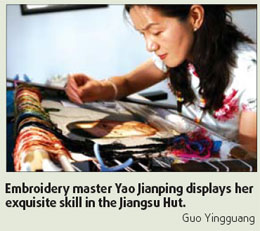Jiangsu Hut

The 80 sq m Jiangsu Hut, with folk music playing in the background, offers visitors a trip through southern China.
Featuring the representative architecture style in the lower reaches of the Yangtze River, the house looks like a waterside pavilion, with a stage surrounded by artificial bamboo and water.
On center stage, two Kunqu opera actresses are playing the classic segment of The Peony Pavilion, a love story written by Tang Xianzu of the Ming Dynasty (1368-1644). Originating near the town of Kunshan in Suzhou 600 years ago, Kunqu is regarded as one of the highest achievements in Chinese traditional opera, combining the essential elements of classical literature, song, dance, opera, painting and acrobatics. It was listed by UNESCO as one of the outstanding regional cultural forms of expression, in the Masterpieces of the Oral and Intangible Heritage of Humanity.
Although there is no electronic screen translating what the actresses are singing, foreign audiences are touched by their elegant movements, tearful eyes and sweet song.
"We saw a Kunqu performance at the Olympic Opening Ceremony, but we can enjoy the art more closely today," says one excited foreign visitor.
At two corners of huts, visitors surround handicraft masters making Suzhou embroideries, zisha ceramics and Huishan terra cotta dolls. Intrigued by the beautiful patterns on the white silk garment fixed to a stand, an American lady couldn't help but practice her "embroidery skills" under the guide of embroidery master Yao Jianping.
Ceramics artists also demonstrated their craftmanship, using zisha (purple clay) clay, which exists exclusively in Yixin, Jiangsu province. After firing the clay, the material is porous enough to absorb tea and maintain its fragrance.
A Yangzhou puppet show, featuring a free-flowing goddess wearing long sleeves was manipulated using only three wooden rods, also impressed visitors.
|
A performer manipulates a Yangzhou puppet in the Jiangsu Hut. Guo Yingguang |
(China Daily 08/23/2008 page15)















